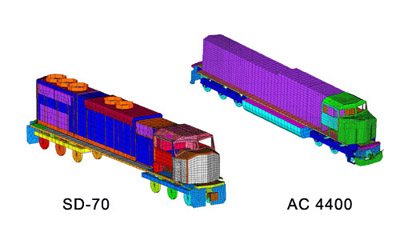Locomotive Occupant Safety
The FRA crashworthiness research program has a long history.1 Initially, the program focus was on passenger equipment but a February 1996 accident in Silver Spring, Maryland that resulted in several fatalities brought a powerful impetus to address the problems of train collisions and their consequences, particularly for the safety of crewmembers occupying the locomotive cab.
Freight railroads also took notice of the FRA crashworthiness initiative, studying the number of injuries and fatalities associated with rail collisions. As a result of this appraisal, the Association of American Railroads (AAR) developed a simple, one-page Locomotive Cab Standard for a short-hood wide-nose cab (S-580-1989) -- developed in part to address an FRA regulation on the subject.
In 1996, the Rail Safety Advisory Committee (RSAC), a joint industry-labor railroad group, requested that an RSAC group re-examine the effectiveness of the simple AAR standard and in 1997 the Locomotive Crashworthiness Working Group was formed. Eventually, the group agreed to a new regulation,2 approved in 2006 and implemented for new locomotives built after January 1, 2009. RD&T supported the technical work of the RSAC group through the Volpe National Transportation Systems Center.
Following these studies, the RSAC studied accidents of significance in depth and identified five major collision types. Subject matter experts catalogued three years of collision data, analyzed two collision scenarios, and assessed the impact of proposed changes.
In 1998, RSAC recognized that additional research was needed to specifically test full-scale locomotive structures and to simulate the various collision scenarios in a manner that allowed for managing their outcomes to mitigate the severity of the resulting injuries and fatalities.
Technical Approach for Locomotive Crashworthiness Research Program
 The technical approach used in this effort consists of four essential parts:
The technical approach used in this effort consists of four essential parts:
- Identify likely train collision scenarios and conduct collision scenario assessments to explore alternate effective means of surviving these scenarios.
- Conduct static testing of locomotive crashworthiness components in a full-scale test machine.
- Model the collision scenarios to reasonably predict outcomes of accidents and to conduct parametric evaluations of designs and at alternate speeds.
- Conduct full-scale testing of locomotive and car structures to verify accident outcome projections.
Simulation capability is also in place, samples of which can be seen below:


Technical Approach for the Locomotive Crashworthiness Research Program
- Static component strength and design evaluations
- Full-scale dynamic testing and simulations
- Crew injury mitigation
Full-scale tests for 10 scenarios have been completed. The elements shown above were part of the program. For example, collision posts were instrumented with strain gauges for static tests in the test fixture. The same locations were used in full-scale dynamic testing.
Footnotes
1. Mayville, R.A., Stringfellow, R G., Rancatore, R.J., and Hosmer, T.P. (1995). Locomotive Crashworthiness Research (Vols. 1–5). DOT/FRA/ORD-95/8.1–8.5.
2. Federal Register, Vol. 71, No. 124, Rules and Regulations (Wednesday, June 28, 2006).
